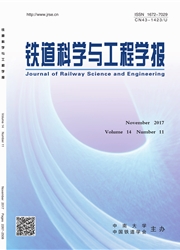

 中文摘要:
中文摘要:
针对广大农村民居低矮房屋抗震能力普遍不足的现状,根据结构隔震理论,提出了一种廉价、施工简便的钢筋-沥青复合隔震层。并以刚体质量块代替刚度较大的砌体建筑物,进行了振动台的模拟试验。结果表明,在不同加速度幅值地震波输入下,由于隔震层吸收了大部分的地震能量,质量块顶部加速度衰减40%-60%,具有较好的减震效果;在加速度幅值为0.30g以下时,隔震层钢筋处于弹性工作状态,在振后能自动复位,并能较好的满足“小震不倒”要求。加速度衰减系数βα随台面输入加速度峰值的增大而整体上呈增大趋势,隔震层上梁和下梁之间的相对位移随台面加速度幅值的增大而增加。
 英文摘要:
英文摘要:
Aimed to the insufficient earthquake - resistance capability of the low - rise buildings in the rural areas, based on the theory of the structure isolation, an inexpensive and construction - convenient steel - asphalt isolation layer was proposed. With rigid mass block in place of low building with larger rigidity, the simulated test on shaking table was carried out. The resuls show that the peak values of acceleration of the mass block is weakened by 40% - 60% when different peak values of the earthquake waves are inputted, due to the energy absorption by the steel -asphalt isolation lay. The steel of the isolation lay works in the elastic range when the peak value of the earthquake wave is below 0.3g. The property that the isolation lay can reset automatically can satisfy the requirements of the seismic design. βa and the relative displacement between the upper beam and the low beam of the isolation lay increased when the larger peak value of earthquake wave is inputted.
 同期刊论文项目
同期刊论文项目
 同项目期刊论文
同项目期刊论文
 期刊信息
期刊信息
